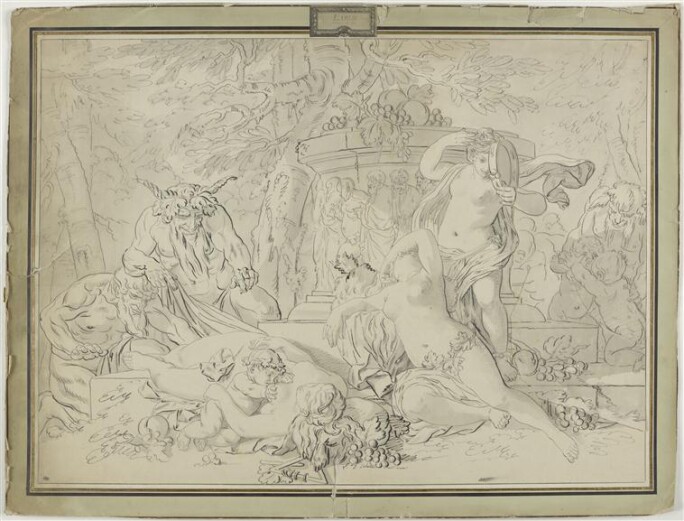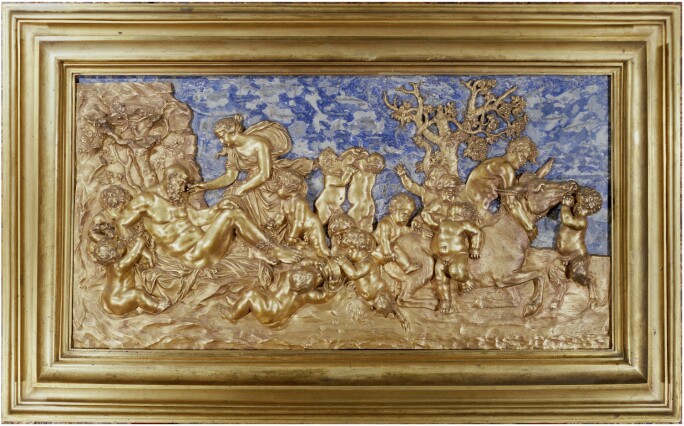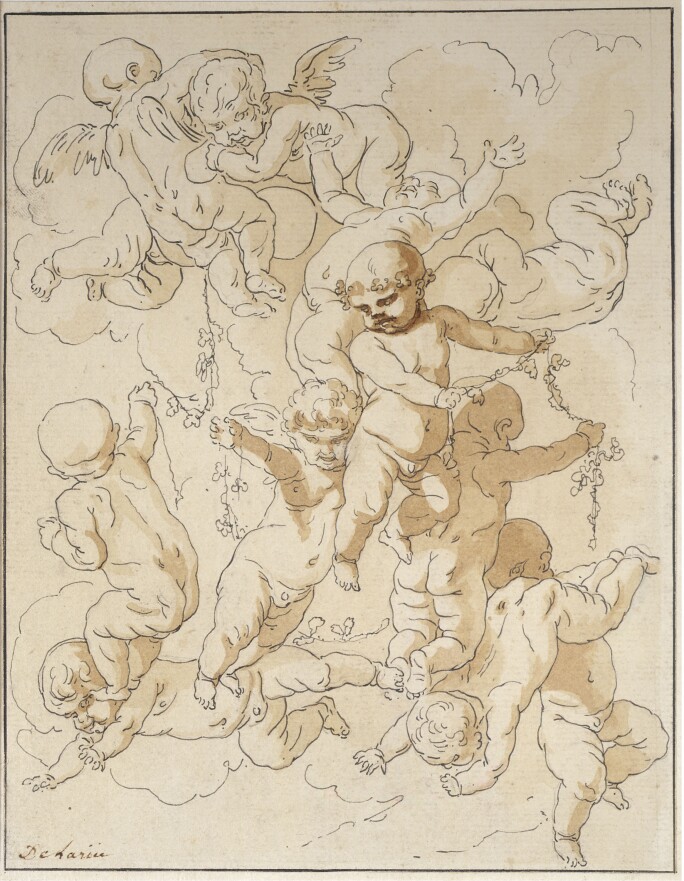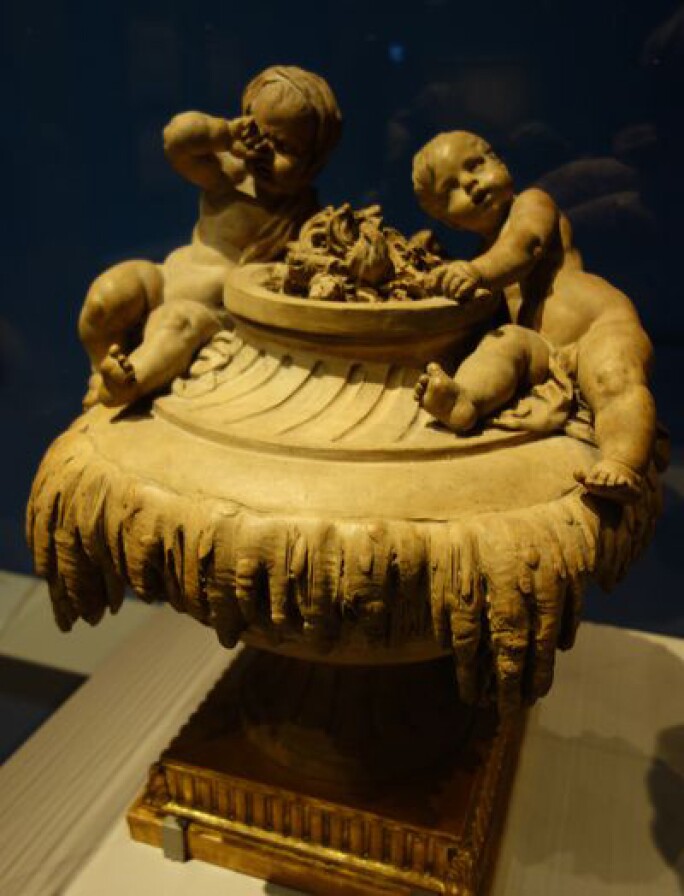This superbly modelled terracotta group representing Silenus surrounded by frolicking putti is a rare rediscovered work by Louis-Félix Delarue, a student of Lambert-Sigisbert Adam (1700-1759) and an elder contemporary of Clodion. The group was owned by two of the great French 18th-century collectors: Pierre Paul Louis Randon de Boisset, and, subsequently, Jean-Baptiste-Pierre Lebrun. Inspired by Jacob Jordaens’ Silenus and the Four Seasons, it combines a Flemish Baroque model with the quintessential elements of the French 18th-century style seen in the work of François Boucher. With its protagonist seated upon a drum-like pedestal, with swirling layers of putti and infant satyrs in both bas-relief and three dimensions, the Randon de Boisset Silenus anticipates Clodion’s celebrated dionysiac compositions, with which it merits comparison.

The Randon de Boisset Silenus and Jacob Jordaens
When the Randon de Boisset Silenus was first sold in the auction of Pierre Paul Louis Randon de Boisset’s collection on 27 February 1777, it was described as:
Un Silène assis sur un piédestal entouré d’enfants & de petits satyres en relief & ronde bosse. La composition de ce morceau distingué est due au génie de François Boucher ; les enfants sont modelés par la Rue, & le satyre est de Jacques Jordaens.
[A Silenus seated on a pedestal surrounded by infants and small satyrs in relief and in the round. The composition of this distinguished piece is due to the genius of François Boucher; the children are modelled by la Rue, and the satyr [Silenus] is that of Jacob Jordaens].
Thus as early 1777 the connection between the Randon de Boisset Silenus and Jacob Jordaens’ Silenus and the Four Seasons was recognised. It is, however, unsurprising that the cataloguer made the link between the two artworks, since Randon de Boisset had united the two within his own unrivalled collection. Jordaens’ picture, now in the Musée Ingres, Montaubin, (inv. no. MID.876.2)(fig. 1), appeared as lot 43 in the Randon de Boisset sale, with the following description:
Un autre beau tableau sur toile de 3 pieds 8 pouces de haut, sur 3 pieds 6 pouces 6 lignes de large ; il est composé de cinq figures. Dans le milieu est Silène ; à droite un Amour qui lui présente un fruit ; tout auprès est une femme avec un panier sur sa tête ; à sa gauche une vieille femme & un homme qui souffle dans un cornet.
[Another beautiful painting on canvas of 3 pieds 8 pouces in height, 3 pieds 6 pouces 6 lignes in length; it is comprised of five figures. Silenus is in the middle; to the right a Cupid who presents him with a fruit; behind is a woman with a panier on her head; to the right an old woman and a man who blows a horn].
It seems possible that Delarue may have chosen the subject to appeal to his patron, or was perhaps working to commission and had the opportunity to study the painting first hand in Randon de Boisset's collection. Whichever is the case, in the Randon de Boisset Silenus, Delarue succeeds in incorporating an academic portrayal of Silenus, the mythical drunken follower of Dionysos, derived from a Flemish Old Master painting, within a sculptural group that is a quintessential manifestation of the French high Rococo style.
Louis-Félix Delarue, French 18th-century sculpture and the Randon de Boisset Silenus
Little is known about Louis-Félix Delarue’s life. However, his importance in the development of French 18th-century sculpture was highlighted by Paul Vitry, Curator of Sculpture at the Louvre in the early 20th century, who commented that:
‘L’art de Clodion […] semble comme en germe dans ces créations d’un artiste pourtant bien oublié. Il s’appelait Félix Delarue, et fut professeur à l’Académie de Saint-Luc.’
[‘The art of Clodion, seems to germinate from the creations of an artist all but forgotten. He was called Félix Delarue, and he was Professor at the Academy of Saint Luke.’]
The enigmatic Delarue is often confused with his brother, the painter and draughtsman, Philibert-Benoît Delarue (1718-1780). Throughout his bibliography, his date of death changes between 1766 and 1770, and has only today been confirmed as 24 June 1777. Even in his own lifetime, the sculptor was presumed dead, such was his absence from the public sphere later in life. When four of his vases were sold in the Lalive de Jully sale in March 1770 the cataloguer wrote, ‘Cet artiste mort depuis peu de temps, a joui d’une reputation dûe à ses grands talens’ [‘This artist, recently deceased, enjoyed a reputation for his great talents’; the sculptor would live for another seven years hence (lot 200, P. de La Vaissière, op. cit., p. 200).

Delarue was trained in the studio of the celebrated sculptor Lambert-Sigisbert Adam (1700-1759), where he may have met the young Clodion who, although some years Delarue’s junior, also worked under Adam. He won the prix de Rome in 1750 with a bas relief entitled ’Abraham rendant grâces à Dieu de la délivrance de son fils (location unknown) and became pensionnaire of the École royal des élèves protégés between 1752 and 1754. In this role, Delarue presented a group entitled Bacchante qui enivre des enfants and four bas-reliefs of the Saisons figurées par des enfants to the king during an exhibition at Versailles in 1754. Before going to Rome in November 1754, he worked under the direction of Jean-Jacques Bachelier at the Manufacture de Vincennes, where he made several groups of frolicking infants, including two presse-papiers models, referred to as ‘plaques à papiers La Rue’. Upon returning to the Académie de France in Rome, of which Natoire was the then director, he was admitted into the Academy of Saint Luke on 13 September 1760. Subsequently, Delarue was named Professor, and, in 1762, exhibited ‘Un marbre, des terre cuites – dont un Dieu Fleuve morceau de réception à Saint-Luc et la paire de vases de la collection Lalive de Jully – et des dessins’. In 1764 he exhibited ‘un relief en plâtre figurant une allégorie de la peinture sous forme d’enfants et des dessins’ (nos. 110 – 112). After 1764, Delarue disappears from the official record and, tragically, is believed to have been plagued by physical frailty and mental illness.
Few terracottas by Delarue have been located. Several are housed in the Musée national de la Céramique including a Bacchus à la panthère (inv. MNC 7741) and the aforementioned ‘plaques à papiers La Rue’, which each represent sets of two infants, the attributes of commerce, the Navy and good government scattered across the terrasses (inv. nos MNC 7742 et MNC 7743). Two groups in soft porcelain of these models were offered to contrôleur général Jean-Baptiste Machault d’Arnouville (Musées des Arts Décoratifs de Paris, inv. n° 31717 (A) et (B)). According to the account books of the Manufacture de Vincennes, Delarue was paid in 1754 for four groups of three children, two of which were based on drawings by Boucher (the plasters are conserved at Musée National de la Céramique, casier 280), and a vase supported by intertwined tritons. Delarue also probably collaborated with the Manufacture subsequent to its relocation to Sèvres, notably for his Enfants Saisons which correspond with four ‘Enfants de La Rue’ mentioned in 1769 in the archives of the Manufacture. Unfortunately no inventory exists of Delarue’s works, though his terracottas appear to date to prior to 1767, after which he focused on drawing.
The Randon de Boisset Silenus and François Boucher
Delarue made engravings after drawings by François Boucher, possibly whilst he was working at the Manufacture de Vincennes. These engravings make explicit the influence of Boucher, who was first painter to the king and one of the most celebrated artists in France, on the young sculptor. Interestingly, the admiration was mutual, since lot 154 in the 1771 sale catalogue of Boucher’s collection is described as:
‘Cinq groupes d’enfants jouant, & un enfant seul tenant des raisins dans sa chemise, par. M. de la Rue’.
[Five groups of playing infants, and one solitary infant holding grapes within its shirt, by M. de la Rue].
The inclusion of works by Delarue within Boucher’s personal collection not merely shows that the sculptor was recognised by his peers and, in this case, his superior, but it also underscores how Delarue’s oeuvre was steeped in the Rococo style, of which Boucher was at the vanguard.

As has been established above, in the 1777 Randon de Boisset catalogue, the present terracotta is said to follow Boucher and include Jordaens’ Silenus. No drawing exists by Boucher which corresponds with the present group. However, the influence of the great painter is clear when a comparison is made between the Randon de Boisset Silenus and Delarue’s engraving of L’Été after Boucher; note the similarly demonstrative and conversely somnambulist putti.
The archetype for sculptural representations of frolicking putti arranged in Dionysiac procession is found in the work of the Flemish sculptor François Duquesnoy (1597-1643), who was active in Rome in the first half of the 17th century, and was known as il fattore de putti. Note, for example, the gilt bronze and lapis relief with the inebriated Silenus surrounded by putti after Duquesnoy in the Rubenshuis, Antwerp (inv. no. RH.B.046)(fig. 3). Duquesnoy’s work continued to be in vogue through to the 18th-century in France. Girardon owned several reliefs by the sculptor, and Delarue may have become familiar with the Fleming’s work through Lambert-Sigisbert Adam, who owned sixteen statuettes of children by Duquesnoy.
Louis-Félix Delarue and Clodion

The influence of Delarue on the young Clodion has been noted by Guilhem Scherf, who has argued that Delarue’s iconographic repertoire was instrumental in Clodion’s formative years as an artist. The relationship between the two is underscored by the fact that a drawing by Delarue is listed in Clodion’s posthumous inventory, ‘Un dessin de La Rue, Jeux d’enfants’ [‘A Drawing by de La Rue, playing infants’] (cf. Poulet and Scherf, op. cit., p. 72). The two in fact collaborated on a pair of bronze and ormolu candelabras sold in the Aubert sale, March 1786, lot 180: ‘Deux figures d’Enfants ; l’un un Satyr, par M. Clodion ; l’autre une petite fille, par Larue’ [‘Two figures of children; one of them a satyr by M. Clodion; the other a small girl, by Larue’]. These may be the examples in the Louvre, inv. nos. OA 5207-8. Anne Poulet has also drawn a comparison between Clodion’s archetypal Paire de vases avec décors de jeux d’enfants (Hermitage, St Petersburg; and a single example sold Christie’s New York, 22 October 2020, lot 142) and a description of a vase by Delarue in the Jullienne sale of 30 March 1767: ‘Vase en terre cuite avec son couvercle ; les anses sont figurées par des masques avec des cornes de bélier est le pourtour est ornés d’une bacchanale d’enfants. Haut. 8 pouces.’ This reference may indicate that Delarue was responsible for creating the progenitor of this type of vase, which raises further interesting questions about his influence on Clodion.
Delarue’s relationship with Clodion is perhaps best illustrated by a comparison between the Randon de Boisset Silenus and one of the latter’s masterpieces, the Model for a Proposed Monument to Commemorate the Invention of the Balloon (Metropolitan Museum of Art, New York, inv. no. 44.21a, b)(fig. 4). The division of the composition into two different levels, and the similar drum-like pedestal with swirling putti and other ethereal beings, makes an interesting parallel with the Randon de Boisset Silenus.
The Randon de Boisset Silenus within Delarue’s wider oeuvre
The Randon de Boisset Silenus with its juxtaposition between the aged, overweight, Silenus, and the charming playful putti, finds numerous concordances in Delarue’s drawings. Most relevant of these is the Transport de Silène sur son âne in the musée du Louvre (inv. no. 27584), in which a similarly inebriated Silenus is carried on a donkey and supported by a youth, whilst putti play on the ground. The drum-like pedestal is prefigured by a round sacrificial altar with bas-reliefs in Delarue’s drawing entitled Bacchanale, also in the Louvre (inv. no. 27592)(fig. 2). Drawings in the musée Cognac Jay, including one which shows Vingt-quatre petits Amours, are comprised of what appear to be clouds of putti in differing poses and states of motion (fig. 5).

Delarue’s known sculptural oeuvre is limited and so few comparables can be found. However, an interesting comparison exists in his Allégorie de l’Hivers, which was sold in the Doucet sale, 6 June 1912, and is now in the Jeffrey Horvitz collection (fig. 6). This beautiful group shows an urn with icicles falling from the brim, and two putti seated about the lid. The Horwitz vase was probably part of a series on the four seasons in the Lalive de Jully collection, his 1770 sale, lot 200, and in the Randon de Boisset collection, his 1777 sale, lot 271: 'Quatre beaux vases, par la Rue ; ils sont ornés chacun de deux enfants et d'attributs qui caractérisent les saisons'.

Significantly, Delarue appears to have made a second version of the Silenus, or a second study of the subject, since, in the Le Brun sale of 1791, lot 358 is described as: ‘Un groupe du vieux Silène et de trois petits enfants aîlés qui le soutiennent, composé avec goût. Hauteur, 6 pouces et demi; largeur 6 pouces’. The location of this group is unknown.
Wider contemporary interest in the subject of the Silenus, is indicated by the fact that Etienne Maurice Falconet made his own version of the model, in which the aged, inebriated, demi-god is flanked by two nymphs, recalling the Biblical story of Lot and his daughters. This group, entitled Silène et les nymphes, was made as a model for the Manufacture de Sèvres and is today in Le Musée national de la Céramique (inv. no. MNC 8003).
The Randon de Boisset Silenus: An Exceptional Provenance

Pierre Paul Louis Randon de Boisset (fig. 7) was a wealthy financier who became Receveur général des finances, and went on to assemble one of the greatest art collections of the 18th century. He was a patron of Jean-Baptiste Greuze, Joseph Vernet, and Hubert Robert, and was a friend of François Boucher, with whom he travelled to Italy twice, in 1752 and then in 1763. Randon de Boisset also visited the Low Countries, in 1766, considerably augmenting his collection during these trips. A celebrated Bibliophile, Randon de Boisset was described thus by Diderot:
'Cet honnête homme, honnête, et très-honnête, fait peu de cas du genre humain, et vit beaucoup pour lui. Il est receveur-général des finances. Il s’appelle Randon de Boisset. Vous ne verrez pas ses tableaux ; mais vous saurez une de ses actions, qui ne vous déplaira pas. Au bout de cinq à six mois de son installation dans la place de fermier-général, lorsqu’il vit l’énorme masse d’argent qui lui revenait, il témoigna le peu de rapport qu’il y avait entre son mince travail et une aussi prodigieuse récompense ; il regarda cette richesse si subitement acquise, comme un vol, et s’en expliqua sur ce ton à ses confrères, qui en haussèrent les épaules, ce qui ne l’empêcha pas de renoncer à sa place. Il est très-instruit. Il aime les sciences, les lettres et les arts. Il a un très-beau cabinet de peinture, des statues, des vases, des porcelaines et des livres. Sa bibliothèque est double. L’une, des plus belles éditions, qu’il respecte au point de ne les jamais ouvrir. Il lui suffit de les avoir et de les montrer. L’autre, d’éditions communes, qu’il lit, qu’il prête, et qu’on fatigue tant qu’on veut. On sait ces bizarreries ; mais on les pardonne à la probité, au bon goût, et au vrai mérite.' (cf. J. Assézat, Œuvres complètes de Diderot, t. XI, Paris, 1876, p. 274)
['This honest man, honest, very honest, thinks little of humanity, and lives very much for himself. He is receveur-général des finances. He is called Randon de Boisset. You will not see his paintings; but you will know of his actions, which will not displease you. After five to six months from his installation as fermier-général, when he saw the enormous sums of money owed to him, he testified on the discrepancy between his low workload and prodigious reward; he regarded this wealth, so suddenly acquired, like a theft, and explained it in his tone to his colleagues, who shrugged their shoulders, which didn't prevent him from relinquishing his position. He is well educated. He loves the sciences, the letters and the arts. He has a very beautiful cabinet of pictures, statues, vases, porcelain and books. His library is replete. One of the most beautiful editions he respects to the point of never opening it. He suffices to own and show them. The other editions, he reads, and lends for as long as one wants. We know these oddities, but they are forgiven for probity, good taste and true merit.'].
Randon de Boisset's apartments on the rue Neuve des Capucines had been remodelled by Jacques-Ange Gabriel, celebrated architect of the Place Louis XV (today the Place de la Concorde) and the Place de la Bourse in Bordeaux. The walls were lined with pictures from floor to ceiling and punctuated with sublime works of art and porcelain. The sale of Randon de Boisset's collection on 27 February 1777 was a sensation. According to Watelet '… vous auriez vu le spectacle de la vente de M. de Boisset, où tous les objets se vendent à des prix inconcevables, même ceux de nos artistes vivants, qui sont en cela plus heureux que les grands artistes anciens…' (cf. M. Beurdeleys, op. cit., p. 48). ['You have viewed the spectacle of the sale of M. de Boisset, where all the objects were sold for inconceivable prices, even those of our living artists, who are in this respect happier than the great old masters']. The sale made the huge sum of 1,356,415 livres, a record for the period. Paintings from the collection by Rembrandt, Rubens, and Van Dyck amongst others are now in the major international museums including the Louvre, the Metropolitan Museum and the Wallace Collection. The 1773 portrait of Randon de Boisset by Jean-Baptiste Greuze is now in the Museum of Fine Arts, Budapest (fig. 7).
Of the 22 European sculptures, eight were terracottas, including four by Delarue and three by Duquesnoy. The present Silenus sold for 915 livres, more than Duquesnoy's Bacchus, whilst a pair of terracotta groups, lot 271, by Delarue achieved the record for terracottas in the sale, selling for 2,200 livres.
The Randon de Boisset Silenus was acquired at the 1777 auction by another great 18th-century collector, Jean-Baptiste-Pierre Lebrun, a descendent of the great Baroque painter to Louis XIV, Charles Le Brun (1619-1690), and the husband of the celebrated court painter Élisabeth Louise Vigée Le Brun (1755-1842). Following the collapse of the Ancien Régime, when his wife was sent into exile Lebrun remained in France and amassed works resulting from revolutionary seizures for the new government. With the support of David, he participated in the creation of a national museum at the palais du Louvre, a role he played until Napoleon came to power. In 1791, amid revolutionary unrest, he chose to sell his collection. However, with the market saturated with artworks from noble families, the present group sold for a fraction of its 1777 price, achieving only 401 livres. To put this into perspective, two busts by Houdon, lot 363, sold for a mere 172 livres. The Randon de Boisset Silenus was probably acquired at the auction by Wolfgang-Guillaume d'Ursel (1750-1804), marshal of the Duchy of Brabant, major general to the king of Bohemia and Hungary, and chamberlain of the Austrian Emperor Joseph II. It descended through the d'Ursel family in obscurity until its recent identification as a lost masterpiece by the forgotten by brilliant contemporary of Clodion, Louis-Félix Delarue.
RELATED LITERATURE
J. -J. Guiffrey, Livrets des expositions de l'Académie de Saint-Luc, 1751, 52, 53, 56, 62, 64 et 74, Paris, 1872, pp. 112-113, 133, 172;
M. Beurdeley, Trois siècles de ventes publiques, Paris, 1988, pp. 48-55;
A. L. Poulet and G. Scherf, Clodion, exh cat. Musée du Louvre, Paris, 1992, pp. 39-40, 50, 57, 72, 82-83, 85, 87, 92, 138, 142, 145-149, 217, 223, 364, 428, 445;
P de la Vaissière, 'L’antiquité en liberté de Louis-Félix Delarue: ses intuitions et sa relecture des Anciens, vers 1755-1760', dans Clodion et la sculpture française de la fin du XVIIIe siècle, Actes du colloque du musée du Louvres, Paris, 1993, pp. 255-84;
J.-F. Delmas, 'Le mécénat des financiers au XVIIIe siècle: étude comparative de cinq collections de peinture', in Histoire, économie et société, 1995, 14e année, n°1. pp. 51-70; I. Wardropper, European Sculpture, 1400-1900, in the Metropolitan Museum of Art, New Haven, London, 2011, pp. 200-202; La Manufacture des Lumières: La sculpture à Sèvres de Louis XV à la Révolution, exh. cat. Musée de la Manufacture de Sèvres, Dijon, 2015, pp. 94-95, 141 and 323;Tradition & Transitions. Eighteenth-Century French Art from the Horvitz Collection, exh. cat.. Petit Palais, Paris, 2017, no. 130